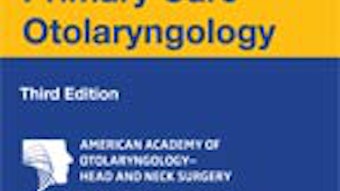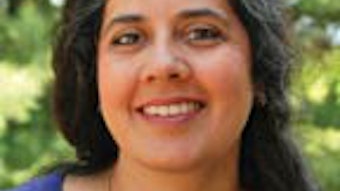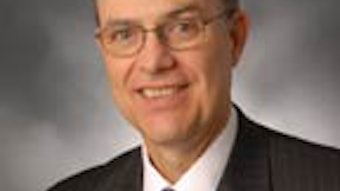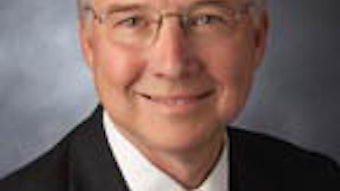Proposed Rule CY 2012 Medicare Physician Fee Schedule
Socioeconomic Survey Results The results of the 2011 Socioeconomic Survey are now available online. Obtain the latest data on productivity, revenue, operations, and other practice patterns for otolaryngology—head and neck surgery at http://www.entnet.org/Practice/members/socioeconomic.cfm. Look for our detailed analysis of the survey in the December 2011 issue. The overall potential impact of the CY 2012 Medicare Physician Fee Schedule (MPFS) for otolaryngology—head and neck surgery will be a 1-percent increase. Note: This amount does not include the possible 29.5-percent reduction to the conversion factor (from $33.9764 to $23.9635) for CY 2012. In the proposed rule, CMS emphasizes its commitment to collaborate with Congress to permanently reform the Sustainable Growth Rate (SGR) methodology for MPFS updates, and we applaud CMS for this effort. The Academy will continue campaigning for a permanent repeal and replacement of the SGR formula. The Academy submitted comments to CMS on the MPFS proposed rule by the August 30, 2011, deadline. Practice Expense (PE) RVUs Policy Changes Impacts The most widespread specialty impacts of the Relative Value Unit (RVU) changes are generally related to several factors. First, CMS will be implementing the third year of the four-year transition to new PE RVUs using the new Physician Practice Information Survey (PPIS) data that were adopted in the CY 2010 PFS final rule. The second factor contributing to the CY 2012 impacts shown in Table 64 (pages 559-560) is a secondary effect of the CY 2011 rescaling of the RVUs so that, in the aggregate, they match the work, Practice Expense (PE), and malpractice proportions in the rebased Medicare Economic Index (MEI) for CY 2011. The rebased MEI had a greater proportion attributable to malpractice and PE and, correspondingly, a lesser proportion attributable to work. This rebasing of the MEI benefitted otolaryngologist—head and neck surgeons because we provide many services with high PE values. Potentially Misvalued Services Under the MPFS CMS proposes to end the practice of conducting separate and “freestanding” Five-Year Reviews of work and PE RVUs, and to instead consolidate these formal Five-Year Reviews with the ongoing annual reviews of potentially misvalued codes. The review for malpractice RVUs will continue to occur at five-year intervals. CMS further proposes an annual process for the public to submit active codes, along with documentation supporting the need for review, and these submissions would occur during the 60-day public comment period following release of the PFS final rule. CMS acknowledges the recent publication of the proposed rule relating to the Fourth Five-Year Review of Work, and also notes that the AMA RUC is currently working to review additional codes. Further, CMS has developed two code lists of potentially misvalued codes, which it proposes to refer to the RUC for review: 91 evaluation and management (E/M) codes listed in Table 6 (pages 92 – 94 of the rule); and 70 high PFS expenditure procedural codes (those with CY 2010 allowed charges of greater than $10 million at the specialty level) listed in Table 7 (pages 95-96) that have presumably not been reviewed since CY 2006. The codes relevant to otolaryngology—head and neck surgery in the latter category are: 31231 (Nasal endoscopy, diagnostic, unilateral or bilateral [separate procedure] which we are currently RUC surveying for the September RUC meeting). 69210 (Removal impacted cerumen [separate procedure], one or both ears). 95117 (Removal impacted cerumen [separate procedure], one or both ears). For each code list, CMS requests that the RUC provide recommendations on the physician times, work RVUs, and direct PE inputs for at least half the codes by July 2012 and the remaining codes by July 2013. CMS rejects the RUC’s recommended work values for various CPT codes including: 42415 (Excision of parotid tumor or parotid gland; lateral lobe, with dissection and preservation of facial nerve). 42420 (Excision of parotid tumor or parotid gland; total, with dissection and preservation of facial nerve). 42440 (Excision of submandibular (submaxillary) gland). CMS’s rationale for this position on these codes is that it believes that the RUC improperly valued “23-hour stay” outpatient services by including inpatient visits, a full rather than a half-day of discharge management service, and/or exchanging inpatient post-operative visits in the original value with subsequent observation care visits, CPT code 99224. As a result, CMS uses a variety of rationales to reduce the work values for these codes, sometimes quite substantially, based on its belief that such values should be based on a different methodology. The Academy disagrees with CMS’s rationale on these codes and plans to address our opposition in our comment letter to CMS. Expanding the MPPR Policy CMS proposes to expand the Multiple Procedure Payment Reduction (MPPR) policy that now applies to the technical component (TC) of advanced imaging services (CT, MRI, and Ultrasound) to the professional component (PC) of such services, all of which are listed in Addendum F of the proposed rule. Under this policy, full payment would be made for the PC of the highest paid procedure, and payment would be reduced by 50 percent for the PC for each additional procedure furnished to the same patient in the same session. Incentives and Payment Adjustments for the eRx Incentive Program For the 2012 and 2013 Electronic Prescribing (eRx) incentive program, CMS proposes that the reporting period will be the entire calendar year (CY) for 2012 and 2013, respectively. To determine the 2013 eRx payment adjustments, in addition to the January 1, 2011, to December 21, 2011, reporting period, CMS proposes a reporting period from January 1, 2012, to June 30, 2012. For the 2014 eRx payment adjustments, CMS proposes a reporting period from January 1, 2012, to December 31, 2012, for individual eligible professionals and January 1, 2013, to June 30, 2013, for group practices. The eRx measure (G8553) as well as the 56 denominator codes (mainly evaluation and management services) used in 2011 will remain the same for CY 2012. EPs are required to select one method of reporting the eRx measure (either via claims, registry, or qualified Electronic Health Records (EHR)). The Academy commented on the potential challenges that our members will encounter because of the reporting periods for this program and will urge CMS to add more exemption categories. Proposed PQRS Changes For 2012, eligible physicians can qualify for a voluntary Physician Quality Reporting System (PQRS) incentive payment of 0.5 percent of their total estimated Medicare Physician Fee Schedule allowed charges for satisfactory reporting. In order to qualify for the incentive, a physician must report on at least 3 PQRS measures 50 percent of the time for claims-based reporting or 80 percent of the time for registry-based reporting January 1-December 31, 2012. New Measures CMS proposes a new measure group to address Sleep Apnea. To report on a measure group, a physician must report on all measures in the group for applicable patients. The Sleep Apnea measure group is the following: assessment of sleep symptoms severity assessment at initial diagnosis positive airway pressure therapy described assessment of adherence to positive airway pressure therapy. CMS also proposes the following new individual measure: referral for Otology Evaluation for Patients with Acute or Chronic Dizziness. Interim Feedback Reports CMS proposes to provide interim feedback reports to physicians who report individual measures and measure groups via claims for 2012 and beyond. The feedback reports will be based on claims for dates of service occurring on or after January 1 and processed by March 31 of the respective program year. The reports will be available summer of 2012 for the 2012 program year. Informal Appeals Process CMS proposes to retain the same informal review process that was put in place for 2011. CMS proposes to base the informal process on their current inquiry process whereby a physician can contact the Quality Net Help Desk (via phone or e-mail) for general PQRS and eRx incentive program information, information on PQRS feedback report availability and access, and/or information on PQRS portal password issues. 2015 PQRS Payment Adjustment CMS has announced reporting periods for the 2015 PQRS payment, and it will be based on the 2013 calendar year. Physicians will have to successfully participate and report on PQRS in 2013 to avoid the 1.5-percent payment adjustment in 2015. For 2016, physicians will receive a 2 percent payment adjustment for successfully reporting in PQRS. Physician Comparison CMS proposes to publish the performance rates of the quality measures that group practices submit under the 2012 Group Practice Reporting Option (GPRO) and to report the performance rates of the quality measures that the group practices participating in the Physician Group Practice demonstration report collected. The Value-Based Modifier For the quality of care measures, CMS proposes to use measures in the core set of the PQRS for 2012, all measures in the GPRO set of the PQRS for 2012, and those in the EHR Incentive Program for 2012. (Find these measures in table 62 [pages 485 – 488] of the proposed rule.) To view a more detailed summary of the proposed rule, visit, http://www.entnet.org/Practice/members/2012PropMPFS.cfm. Reference Medicare Program; Payment Policies under the Physician Fee Schedule and Other Revisions to Part B for CY 2012; Proposed Rule. Accessed at http://tinyurl.com/NPRMMPFS on August 10, 2011.
| Socioeconomic Survey Results
The results of the 2011 Socioeconomic Survey are now available online. Obtain the latest data on productivity, revenue, operations, and other practice patterns for otolaryngology—head and neck surgery at http://www.entnet.org/Practice/members/socioeconomic.cfm. Look for our detailed analysis of the survey in the December 2011 issue. |
The overall potential impact of the CY 2012 Medicare Physician Fee Schedule (MPFS) for otolaryngology—head and neck surgery will be a 1-percent increase. Note: This amount does not include the possible 29.5-percent reduction to the conversion factor (from $33.9764 to $23.9635) for CY 2012. In the proposed rule, CMS emphasizes its commitment to collaborate with Congress to permanently reform the Sustainable Growth Rate (SGR) methodology for MPFS updates, and we applaud CMS for this effort. The Academy will continue campaigning for a permanent repeal and replacement of the SGR formula. The Academy submitted comments to CMS on the MPFS proposed rule by the August 30, 2011, deadline.
Practice Expense (PE) RVUs Policy Changes Impacts
The most widespread specialty impacts of the Relative Value Unit (RVU) changes are generally related to several factors. First, CMS will be implementing the third year of the four-year transition to new PE RVUs using the new Physician Practice Information Survey (PPIS) data that were adopted in the CY 2010 PFS final rule. The second factor contributing to the CY 2012 impacts shown in Table 64 (pages 559-560) is a secondary effect of the CY 2011 rescaling of the RVUs so that, in the aggregate, they match the work, Practice Expense (PE), and malpractice proportions in the rebased Medicare Economic Index (MEI) for CY 2011. The rebased MEI had a greater proportion attributable to malpractice and PE and, correspondingly, a lesser proportion attributable to work. This rebasing of the MEI benefitted otolaryngologist—head and neck surgeons because we provide many services with high PE values.
Potentially Misvalued Services Under the MPFS
CMS proposes to end the practice of conducting separate and “freestanding” Five-Year Reviews of work and PE RVUs, and to instead consolidate these formal Five-Year Reviews with the ongoing annual reviews of potentially misvalued codes. The review for malpractice RVUs will continue to occur at five-year intervals. CMS further proposes an annual process for the public to submit active codes, along with documentation supporting the need for review, and these submissions would occur during the 60-day public comment period following release of the PFS final rule.
CMS acknowledges the recent publication of the proposed rule relating to the Fourth Five-Year Review of Work, and also notes that the AMA RUC is currently working to review additional codes. Further, CMS has developed two code lists of potentially misvalued codes, which it proposes to refer to the RUC for review: 91 evaluation and management (E/M) codes listed in Table 6 (pages 92 – 94 of the rule); and 70 high PFS expenditure procedural codes (those with CY 2010 allowed charges of greater than $10 million at the specialty level) listed in Table 7 (pages 95-96) that have presumably not been reviewed since CY 2006. The codes relevant to otolaryngology—head and neck surgery in the latter category are:
- 31231 (Nasal endoscopy, diagnostic, unilateral or bilateral [separate procedure] which we are currently RUC surveying for the September RUC meeting).
- 69210 (Removal impacted cerumen [separate procedure], one or both ears).
- 95117 (Removal impacted cerumen [separate procedure], one or both ears).
For each code list, CMS requests that the RUC provide recommendations on the physician times, work RVUs, and direct PE inputs for at least half the codes by July 2012 and the remaining codes by July 2013.
CMS rejects the RUC’s recommended work values for various CPT codes including:
- 42415 (Excision of parotid tumor or parotid gland; lateral lobe, with dissection and preservation of facial nerve).
- 42420 (Excision of parotid tumor or parotid gland; total, with dissection and preservation of facial nerve).
- 42440 (Excision of submandibular (submaxillary) gland).
CMS’s rationale for this position on these codes is that it believes that the RUC improperly valued “23-hour stay” outpatient services by including inpatient visits, a full rather than a half-day of discharge management service, and/or exchanging inpatient post-operative visits in the original value with subsequent observation care visits, CPT code 99224. As a result, CMS uses a variety of rationales to reduce the work values for these codes, sometimes quite substantially, based on its belief that such values should be based on a different methodology. The Academy disagrees with CMS’s rationale on these codes and plans to address our opposition in our comment letter to CMS.
Expanding the MPPR Policy
CMS proposes to expand the Multiple Procedure Payment Reduction (MPPR) policy that now applies to the technical component (TC) of advanced imaging services (CT, MRI, and Ultrasound) to the professional component (PC) of such services, all of which are listed in Addendum F of the proposed rule. Under this policy, full payment would be made for the PC of the highest paid procedure, and payment would be reduced by 50 percent for the PC for each additional procedure furnished to the same patient in the same session.
Incentives and Payment Adjustments for the eRx Incentive Program
For the 2012 and 2013 Electronic Prescribing (eRx) incentive program, CMS proposes that the reporting period will be the entire calendar year (CY) for 2012 and 2013, respectively. To determine the 2013 eRx payment adjustments, in addition to the January 1, 2011, to December 21, 2011, reporting period, CMS proposes a reporting period from January 1, 2012, to June 30, 2012. For the 2014 eRx payment adjustments, CMS proposes a reporting period from January 1, 2012, to December 31, 2012, for individual eligible professionals and January 1, 2013, to June 30, 2013, for group practices. The eRx measure (G8553) as well as the 56 denominator codes (mainly evaluation and management services) used in 2011 will remain the same for CY 2012. EPs are required to select one method of reporting the eRx measure (either via claims, registry, or qualified Electronic Health Records (EHR)). The Academy commented on the potential challenges that our members will encounter because of the reporting periods for this program and will urge CMS to add more exemption categories.
Proposed PQRS Changes
For 2012, eligible physicians can qualify for a voluntary Physician Quality Reporting System (PQRS) incentive payment of 0.5 percent of their total estimated Medicare Physician Fee Schedule allowed charges for satisfactory reporting. In order to qualify for the incentive, a physician must report on at least 3 PQRS measures 50 percent of the time for claims-based reporting or 80 percent of the time for registry-based reporting January 1-December 31, 2012.
New Measures
CMS proposes a new measure group to address Sleep Apnea. To report on a measure group, a physician must report on all measures in the group for applicable patients. The Sleep Apnea measure group is the following:
- assessment of sleep symptoms
- severity assessment at initial diagnosis
- positive airway pressure therapy described
- assessment of adherence to positive airway pressure therapy.
- CMS also proposes the following new individual measure:
- referral for Otology Evaluation for Patients with Acute or Chronic Dizziness.
- Interim Feedback Reports
CMS proposes to provide interim feedback reports to physicians who report individual measures and measure groups via claims for 2012 and beyond. The feedback reports will be based on claims for dates of service occurring on or after January 1 and processed by March 31 of the respective program year. The reports will be available summer of 2012 for the 2012 program year.
Informal Appeals Process
CMS proposes to retain the same informal review process that was put in place for 2011. CMS proposes to base the informal process on their current inquiry process whereby a physician can contact the Quality Net Help Desk (via phone or e-mail) for general PQRS and eRx incentive program information, information on PQRS feedback report availability and access, and/or information on PQRS portal password issues.
2015 PQRS Payment Adjustment
CMS has announced reporting periods for the 2015 PQRS payment, and it will be based on the 2013 calendar year. Physicians will have to successfully participate and report on PQRS in 2013 to avoid the 1.5-percent payment adjustment in 2015. For 2016, physicians will receive a 2 percent payment adjustment for successfully reporting in PQRS.
Physician Comparison
CMS proposes to publish the performance rates of the quality measures that group practices submit under the 2012 Group Practice Reporting Option (GPRO) and to report the performance rates of the quality measures that the group practices participating in the Physician Group Practice demonstration report collected.
The Value-Based Modifier
For the quality of care measures, CMS proposes to use measures in the core set of the PQRS for 2012, all measures in the GPRO set of the PQRS for 2012, and those in the EHR Incentive Program for 2012. (Find these measures in table 62 [pages 485 – 488] of the proposed rule.)
To view a more detailed summary of the proposed rule, visit, http://www.entnet.org/Practice/members/2012PropMPFS.cfm.
Reference Medicare Program; Payment Policies under the Physician Fee Schedule and Other Revisions to Part B for CY 2012; Proposed Rule. Accessed at http://tinyurl.com/NPRMMPFS on August 10, 2011.



